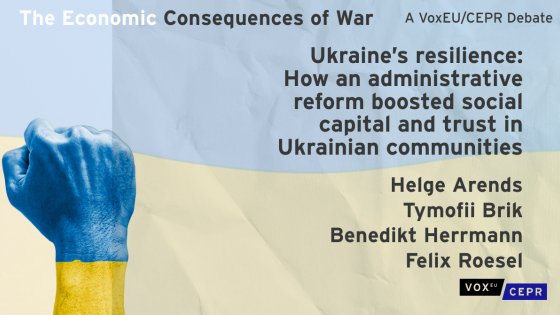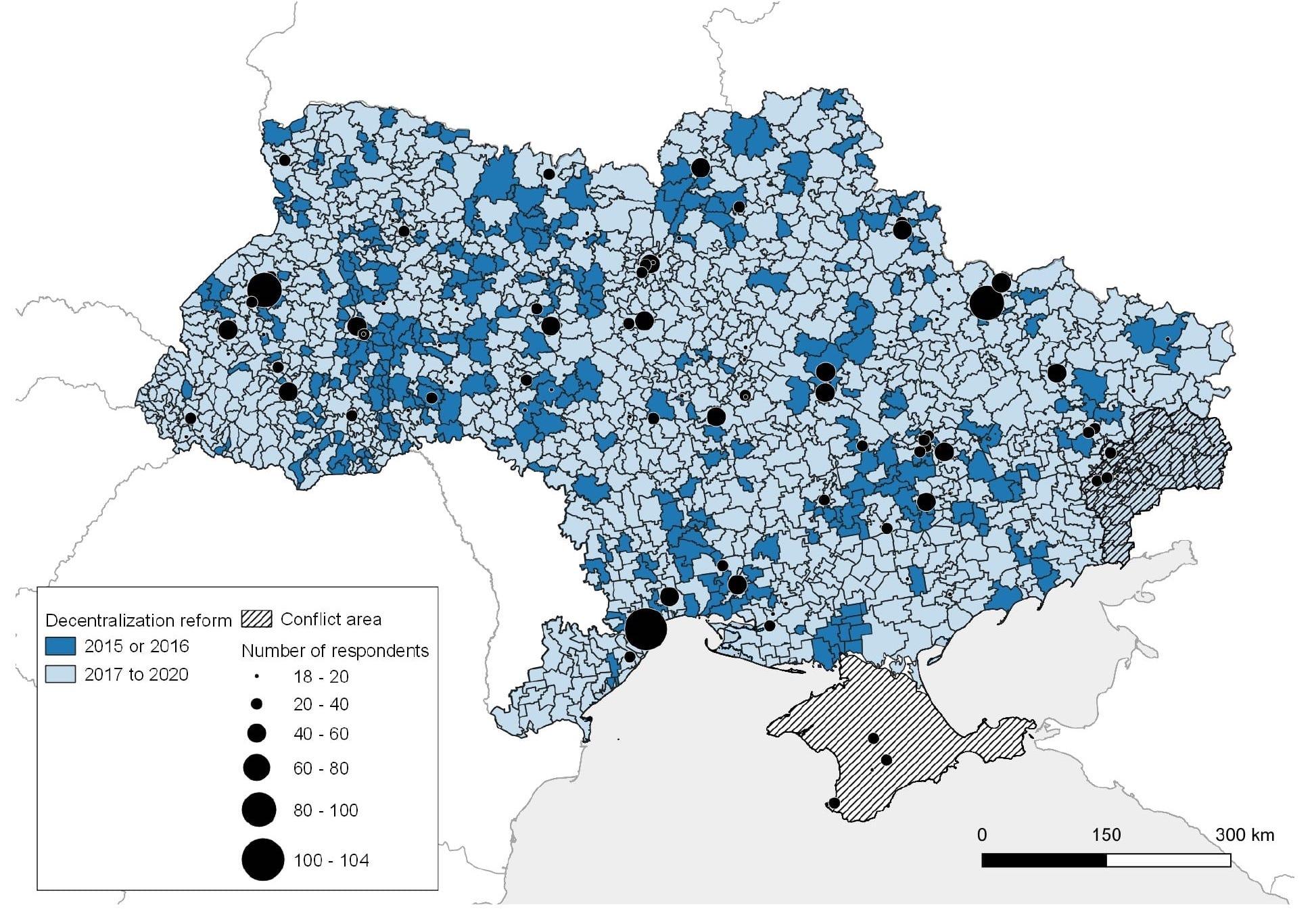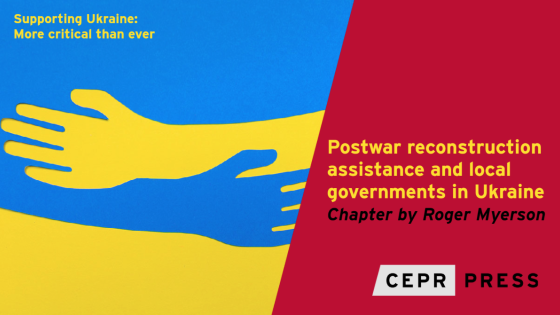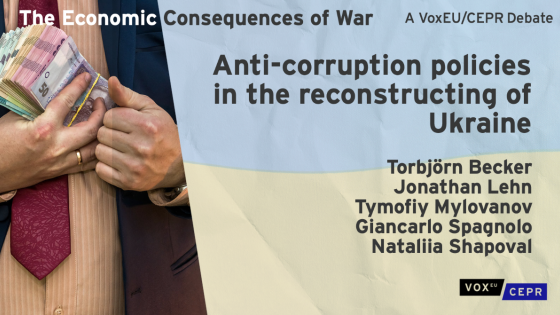Ukraine’s unexpected resilience in the face of a full-scale Russian invasion in 2022 surprised many scholars, politicians, and pundits. Previously perceived as a society with low social capital and civic commitment (Gatskov and Gatskova 2020), Ukraine saw a dramatic increase in social unity and engagement. Explanations ranged from the leadership of President Volodymyr Zelensky, to the rallying effect of the nation around its flag, to cultural factors. Scholars attuned to the intricacies of Ukrainian society noted the significant role of social capital and its relation to decentralisation reform (Myerson 2022, Brik and Murtazashvili 2022), arguing that such a dynamic provided the necessary autonomy, incentives, and motivation for Ukrainians to fight back, as they felt directly involved in their own local self-governance.
Did Ukraine’s decentralisation reform lead to an enhancement of social capital? Our analysis (Arends et al. 2023) of microdata supports this hypothesis.
Decentralisation reform in Ukraine
In the early days of independence, achieved on 24 August 1991, Ukraine inherited the Soviet legacy of centralisation. Councils at regional, district, and local levels were largely dependent on a central administration. This centralised structure remained more or less in place until 2014, when a decentralisation reform was implemented. The idea of the reform was outlined in a concept paper published by the national government on 1 April 2014. By the end of that year, the Parliament of Ukraine had amended the budget code to provide direct transfers from the Ministry of Finance to villages and cities that voluntarily amalgamated into local self-governments, so called ‘territorial hromadas’. This independence from local branches of national administration allowed these newly formed local governments to receive 60% of the personal income tax collected within their jurisdiction. The first hromadas were formed in 2015 and more followed. By 2020, all 1,470 new Ukrainian local governments had been formed. We exploit this specific feature of a staggered roll-out of the reform.
Further decentralisation occurred in February 2015 with the adoption of a law concerning the voluntary amalgamation of over 11,000 villages into new hromadas. In turn, the newly amalgamated hromadas were empowered by receiving more responsibilities, which were passed down primarily from the district level. The law defined local self-governance as the responsibility for local public goods, which came to include maintaining local libraries, childcare centres, schools, health care centres, fire and civil protection departments. Though salaries for schoolteachers and medical personnel remained the responsibility of the central state, local management had the power to select school directors, organise the school network, maintain and construct local roads, plan land use, and even own formerly state-held land within their jurisdiction. This radical reform came with no blueprint or previous experience to draw from, and there was often little support from the national authorities – sometimes even resistance.
Despite these challenges, setting up local self-governance required the involvement of the local population and civil society. The process intensified citizen engagement in ways not seen in many parts of Ukraine for a long time. The pioneering communities formed in 2015 and 2016 are therefore a particularly interesting case to examine the impact of this grassroots process in decentralisation. Our study focuses on these specific communities and refers to the time before February 2022, without accounting for the events that unfolded afterwards. However, we argue that the conclusions about decentralisation and trust are important to consider when explaining Ukraine’s current high level of resilience.
Empirical strategy and results
The implementation of local autonomy across all Ukrainian cities and villages spanned more than six years. Our empirical strategy consists of comparing the level of trust among individuals in already empowered communities with that in yet-to-be empowered communities, taking into account pre-existing differences. We use microdata on trust from the 2010 and 2016 waves of the Life in Transition (LiTS) survey, a major study conducted primarily in former Communist countries by the European Bank for Reconstruction and Development (EBRD). All 3,066 Ukrainian respondents from the two LiTS surveys were georeferenced. In most of our analysis, we exclude the capital, Kyiv, and the occupied areas in the Donetsk and Luhansk regions, where Russia had control from 11 May 2014 on, reducing our dataset to 2,679 observations. However, our results do not change when including these previously excluded observations.
As the LiTS survey was conducted in 2016, respondents residing in the 327 pioneer reform communities established in 2015 or 2016 make up our treatment group, while those living in one of the 1,143 communities formed after 2016 constitute our control group. We account for the staggered nature of the Ukrainian decentralisation reform in difference-in-differences estimations, using standard regressions with ordinary least squares (OLS) and robust standard errors.
Figure 1 Decentralisation reform in Ukraine between 2015 and 2020
Notes: The map shows the 1470 Ukrainian communities (hromadas), created the course of a large decentralization reform starting in 2015. Hromadas are granted considerable powers and autonomy over budgets and local affairs by the national government. Dark shaded hromadas were formed in 2015 or 2016 and are our treated group; light shaded hromadas followed between 2017 and 2020 and serve as control group. Hatched territories refer to the conflict areas between 2014 and February 2022. Our study refers to the time before February 2022 and do not account for the events afterwards. Bullets indicate the locations of 3066 respondents of the two geocoded LiTS survey waves in 2010 (including respondents in later conflict areas) and 2016; bullet size coincides with the number of observations per location. Out of 3066 observations, 285 were living in pioneering hromadas (2010: 145, 2016: 140).
Our results show that the probability of reporting trust in local governments increases by some 17% in empowered communities. The effect is substantial, given that on average only 24% of all residents report trust in local governments, and it is statistically significant at the 1% level. By contrast, trust in institutions at higher levels – such as regional or national governments, parliament, or the president – does not change. Point estimates are close to zero and none of the effects is statistically significant at the conventional levels. Local autonomy clearly maps onto more trust in local governments but does not spill over to other institutions, at least in the short term. We also find that the results are lasting at least until the year 2020, and map onto higher voter turnout in local elections.
Decentralisation affects trust in local institutions via two channels. First, decentralisation can enable the tailoring of public services to local needs, which may increase satisfaction with policies and translate into trust. Second, the process of forming new communities from the bottom up was a key element of the decentralisation process in Ukraine. When the process of voluntary amalgamation started, citizens knew that 60% of their personal income tax would go towards the budget of ‘their’ new hromada. So it became vital to citizens to participate in the process, and shape the form and structure of their own, new, local self-government. Our analysis indicates a process in line with the latter mechanism, since we do not register an increase in satisfaction with local public services, but we do register an increase of trust in peers and neighbours. The most likely mechanism is the democratic process of coming together to build new local communities.
Conclusions
Ukraine’s decentralisation reform is a prime example of building trust in local government by empowering local communities. The national government devolved powers and resources to newly formed local governments (hromadas) between 2015 and 2020, including a significant share of taxes on local incomes. Our difference-in-differences estimations show that citizens in empowered communities report more trust in local authorities and participate more often in local elections. The most likely mechanism is the democratic process of coming together to build new local communities, triggered by the awareness that ‘our’ taxes would go to ‘our’ self-government in the future.
Decentralisation reforms elsewhere usually proceed without such fundamental changes of the territorial and fiscal structure to the benefit of new local self-governments. Via this channel, trust in local authorities increases in newly formed local governments that enjoy local autonomy, self-governance, and substantial financial resources. The democratic process of coming together to jointly design new institutions appears to trigger trust in local peers. Decentralisation, when combined with own revenues and fiscal resources, translates into a powerful tool for increasing political trust in local institutions, particularly when decentralisation is accompanied by a rich democratic process, intense interactions, and the understanding that citizens will pay a significant part of their taxes to their own municipality, not to a national government that cannot be held easily accountable for decisions on how those taxes are spent. The increased level of trust through decentralisation reform may explain the critical role hromadas played in building resilience during the 2022 invasion, as empowered municipalities backed by strong trust of their citizens can work more effectively. While decentralisation reform can be crucial to debates about post-war reconstruction (e.g. Gorodnichenko et al. 2022), other countries might benefit from taking inspiration from the Ukrainian model, which focused on the creation of municipalities with substantial own revenues.
Authors' note: The views expressed are purely those of the authors and may not in any circumstances be regarded as stating an official position of the European Commission.
References
Arends, H, T Brik, B Herrmann and F Roesel (2023), “Decentralization and Trust in Government: Quasi-experimental Evidence from Ukraine”, Journal of Comparative Economics, forthcoming.
Brik, T and J Murtazashvili (2022), “The source of Ukraine’s resilience: how decentralized government brought the country together”, Foreign Affairs 28.
Gatskov, M and K Gatskova (2020), “Civil Society in Ukraine”, Ukraine in Transformation: From Soviet Republic to European Society: 123–144.
Gorodnichenko, Y, I Sologoub and B Weder di Mauro (2022), Rebuilding Ukraine: Principles and Policies, CEPR Press, 7 December.
Myerson, R (2023), "Postwar Reconstruction Assistance and Local Governments in Ukraine", VoxEU.org, 9 March.








